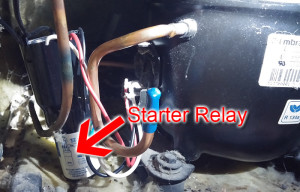When your refrigerator stops cooling there can be more than a dozen causes. And depending on where you’re located in the country, the primary causes can vary a lot. Here in Phoenix, refrigerators have to work harder than they do in other places. Please be careful when searching the net for information. The main cause for a refrigerator not cooing in Washington will not be the same as it is here in Phoenix. Below we’ve listed some of the more common reasons, as seen by our techs, for your information.
1. Condenser Coils are Dirty. On some refrigerators the condenser coils are located at the very bottom of your refrigerator. Over time the coils can collect dust and hair and become ineffective. For a lot of people, simply cleaning these coils will get there refrigerator cooling properly again.
2. Evaporator Fan Motor. Every refrigerator has a set of coils called an evaporator. The evaporator is the source of cold air for the whole unit.
The Evaporator Fan Motor circulates the cold air created by the evaporator coils, except when it stops working.
The evaporator coils are usually silver in color and covered in a layer of frost. When you find the evaporator coils, you’ll find the evaporator fan motor.
3. Condenser Fan Motor. A refrigerator works by removing heat from the unit. The heat is removed by the condenser coils. The condenser coils need to be cooled by the condenser fan. If the condenser fan stops working, the coils won’t be cooled, and the unit can overheat and shut down.
Sometimes the condenser fan motor can get things caught in the blades-which will make it stop working. Before you call a tech, unplug the unit and check the evaporator fan blades (it’s the fan next to the compressor.)
4. The Temperature Control Thermostat is a temperature sensitive switch that tells the refrigerator to start or stop cooling based on its internal temperature. When the thermostat stops working, the thermostat stops telling the refrigerator it’s time to cool again.
5. The Start Relay is a small rectangular switch located on your compressor. The Start relay gives a little boost of electricity to the compressor to get it running.
compressor. The Start relay gives a little boost of electricity to the compressor to get it running.
These can go out over time, and when they do, you compressor wont kick on. If the compressor doesn’t kick on, the refrigerator will not cool.
6. The Start Capacitor is a battery that gives the compressor a little boost when firing up. When the capacitor fails, the compressor can’t start, and the unit can’t cool. The capacitor is different from the relay, but is located in the same vicinity.
7. The Thermistor monitors the refrigerator like a thermostat does. This part is connected to the control boards in newer units. When it fails the refrigerator will either stop cooling, or build up with ice.
8. Temperature Control Board is a part you hope you don’t need. They’re expensive, and hard to diagnose. And up until now, all the parts can be tested for voltage or continuity with a multi-meter. It’s not so easy when it comes to control boards.
The board’s job is to provide voltage to the fan motors and the compressor. Most people conclude that they need a board via process of illumination. If you checked everything else on the list, and it’s all fine, then you replace the board.
9. The Compressor is a motor that circulates the refrigerant through the system. It’s usually (hopefully) the last thing to go. It’s also one of the few parts that, legally, must be changed by a license professional. Keep in mind that the compressor not working does not mean that the compressor is bad. Check everything but the fans before looking into the compressor.
10. Like the compressor, the Main Control Board is not likely to fail. You should check everything (even the fans,) before looking into the main control board.
If you have some electrical knowledge, and you’re kinda handy, then we recommend you begin by cleaning the condenser coils and then checking the fans and thermostats. Beyond that, it can get a little complicated. There’s a learning curve that most budding technicians go through. If you’re losing food, or have a restaurant to run, it’s best to call a technician. If you’re in the Phoenix area, we’d be happy to help. We can be reached at (602) 790-5486.